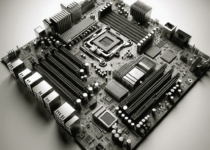No Signal to Monitor: Troubleshooting Guide
When you turned on your computer, did you ever turn to see a blank screen looking back at you? It can be annoying, particularly if you have a job to do. This “no signal” issue is frequently seen, according to our qualified computer specialist. The good news is that it can frequently be resolved with some simple troubleshooting.
We outlined the most frequent reasons why a monitor is plugged in but there is no signal problem, along with step-by-step instructions for resetting your display, based on discussions with industry professionals. All from broken cables to fixing software issues will be covered.
PC Booting Up With No Monitor Signal
Although a working display is necessary for a seamless computer experience, users could run into an issue that breaks this critical connection. This problem, also known as the “No Signal” fault, arises when a computer system turns on, but the output on the monitor is blank. Users are left feeling bewildered and frustrated as the screen stays black and lacks any images.
The “No Signal” issue, which stops them from accessing their files, apps, and operating systems. The lack of a visible display makes the computer practically useless for work, communication, or amusement. For those who depend significantly on their computers for their jobs, this can be a particularly troubling issue.
Several parts of the computer system could be the source of the “No Signal” issue. Some of the possible causes of this annoying problem are loose connections to cables, graphics card malfunctions, abnormalities in the display, driver-related issues, and power supply problems. Therefore, it is crucial to troubleshoot and resolve the “No Signal” issue.
Understand the “Monitor Plugged In But No Signal” Issue
An annoying issue that arises when a computer starts up but the monitor is unable to receive and show any visual output is called the “No Signal” error. When there is no signal, users see a blank screen, which confuses them and makes them worry about the health of their computer system. The error may occur at the computer’s initial setup or while it is operating, and it may be caused by several hardware, software, or configuration-related problems.
Fundamentally, the “No Signal” error denotes a communication failure between the input of the monitor and the computer’s graphical output. The display cannot show any content because the monitor cannot recognize a legitimate video stream from the computer. Several things could be causing this signal transmission stoppage, such as bad connections, broken hardware, out-of-date or damaged drivers, or even incorrect BIOS settings.
Possible Causes for the Issue
- Loose Cable Connections
An incorrectly attached or loose wire is one of the most frequent causes of the “No Signal” error. It’s possible that the VGA, HDMI, DisplayPort connector, or DVI cables—which carry signals from video from the workstation to the monitor—are not fastened firmly enough. Similar to this, unsecured power cords that feed the monitor with electricity could also prevent the two devices from communicating properly.
- Graphics Card Problems
One essential part that is in charge of producing visuals and audio on the monitor is the graphics card (GPU). The “No Signal” error may occur if the GPU is broken, mistreated, or malfunctioning. Problems like overheating, hardware malfunctions, or insufficient power to the graphics card may also bring on this issue.
- Monitor or Display Issues
The “No Signal” problem may be caused by issues with the monitor itself, such as malfunctioning internal components, damaged ports, or hardware flaws. Additionally, the display may not be able to detect the inbound video signal if the input source settings are configured incorrectly.
- Driver-Related Problems
Graphics drivers that are out of current, incompatible, or corrupt might make it difficult for the GPU and the monitor to communicate. The “No Signal” error may appear if the drivers that are in charge of enabling the video signal are not operating properly.
- Power Supply Issues
The “No Signal” issue may be caused by an inadequate power supply to the whole thing or certain hardware parts, like the graphics card. A correct video signal from the GPU to the monitor may not be transmitted if there is inconsistent power delivery.
Comprehending these plausible origins offers a basis for accurately identifying and resolving the “No Signal” problem. Users can reestablish the crucial connection between their computer and the monitor by carefully examining each of these variables to systematically determine the core cause of the issue and carry out the necessary troubleshooting procedures.
How to Fix the Monitor Plugged in But No Signal Issue? [13 Proven Ways to Fix]
Now let’s discuss the topic.
- To receive the signal, choose the appropriate input source:
The first and most basic error is not selecting the appropriate monitor mode. For instance, you used an HDMI cable to link the CPU and the monitor. However, HDMI is not detected by the display; instead, it searches for signals from DVI, VGA, and other connectors.
In this instance, the signal’s route was displayed incorrectly, thus even though the CPU and monitor are operating OK, your monitor won’t receive signals from the CPU
Resolve it:
Utilizing the buttons on your monitor to access the monitor menu, you may quickly resolve this problem. Choose the appropriate port to use by first selecting the ‘Input Source’ option from the menu.
All you have to do is pick the “Auto Select” option. To obtain the signals, the monitor will select the active port. My Dell U2412M monitor’s settings menu is visible to you. These configurations differ from machine to device depending on the model of your monitor. Here are some methods for locating the brand, model, and specifications of a monitor.
Not receiving a signal at all? Proceed to the following action.
- Eject and input the cable to avoid a loose connection:
Have you plugged the cord incorrectly? The reason I’m asking is that faulty connections have the potential to stop signals from the CPU from reaching the monitor.
Resolve it:
Re-insert the cable after unplugging it on both ends. This remedy will work for you if the loose connection is the cause of your issue.
You performed all the necessary steps, and the screen showed the same thing. Be at ease; continue searching for the appropriate issue and its resolution.
- Your PC requires a Graphics Processing Unit (GPU):
An additional graphics card is not necessary for motherboards with built-in graphics to function. However, not every motherboard can have integrated graphics memory. In situations like these, your computer needs an external graphics card.
The monitor displays “No Signal” when your PC lacks a GPU and the motherboard is unable to provide integrated graphics RAM because the monitor is not receiving the proper signals from the motherboard.
Resolve it:
Here, to deliver the signal to your monitor, your PC needs a graphics card. A GPU for your PC is available on Amazon.com. Verify that the GPU and your motherboard are compatible.
- Plug the cable on the GPU port rather than the motherboard:
Your PC has a graphics card, but the monitor isn’t functioning. In this instance, you must examine the cable’s course.
Just make sure you’re plugging the GPU into the screen or the motherboard wire into the monitor once.
Resolve it:
Modify the cable’s path from GPU to monitor
if you connect it from the motherboard to the monitor. Verify that the same ports are shared by the GPU and the monitor. If not, you ought to use converters such as Display to HDMI or HDMI to DisplayPort, among others.
- Make proper connections of Front Panel Connectors:
A ‘No Signal’ message on your monitor screen indicates that the power pin connectors are not connected correctly. Because these connectors are so small, it’s easy to become confused when assembling them.
One of the frequent errors made when building a PC is connecting the power pins incorrectly.
Resolve it:
You can address the problem with the aid of a manual for attaching connectors on the front panel.
- Don’t forget to place RAM sticks on your motherboard:
It makes sense that you might forget to do something. It is possible to overlook installing RAM on the motherboard when creating your PC. It may occur in your case right now.
Incorrect RAM installation can occasionally also result in this problem. Inadequate RAM installation is another issue if your computer is unable to locate the BIOS. Look for more factors that impact the PC BIOS booting.
Resolve it:
Make sure you have inserted the RAM sticks by checking them once. And if you happen to miss it, put it in.
If it has already been installed, take the RAM stick out of the slot and reposition it correctly.
- Incompatible GPU doesn’t work out
A computer’s motherboard is compatible with certain parts, or compatible components. You are wasting money and time on an incompatible part.
For instance, you are attempting to operate your PC on a DDR4 GPU, even though your motherboard only supports DDR3 GPUs. You may then claim that your graphics card is a part of your PC that is incompatible.
In this instance, there is little question that your computer will display no signal error since the motherboard and graphics card are out of sync, making it impossible for a computer to work properly. You need to know what kind of motherboard you have to locate parts that work with your computer.
Resolve it:
Always ensure that the components you buy for your PC are suitable for your motherboard.
Turn on your computer after swapping out your old GPU for a compatible one. Consult the motherboard handbook to determine which parts of your computer are compatible.
- Eject and reinsert the Graphics card to get the signal:
A ‘No Signal’ warning on your computer may be the result of improper graphics card installation. If you are certain that every component of your PC is compatible, you still need to make sure that the graphics card is installed correctly.
Resolve it:
A quick repair is to remove your GPU and re-insert it into your computer.
- Use the Reset button on your CPU:
You ask something like, “I know the parts of the PC. They mesh well together, and I think I positioned them well. I still find the No Signal error annoying, though. How should I proceed?”
Certain machines have difficulty analyzing the latest modifications. You can use this fix, so don’t worry.
Resolve it:
The CPU’s reset button
The CPU casing has a second button labeled the “Reset button” in addition to the power button. In this instance, solving the issue might be helpful.
Most of the time, restarting your computer will solve these kinds of issues. Close any open applications on your desktop and hit the restart button.
- Is the converter doing the right thing?
Are you converting GPU signals to monitor signals using a converter?
A converter is an electrical device that can modify the signals that are sent to the monitor from the source (a GPU or motherboard). The market is filled with several types of converters, such as Display to HDMI and HDMI to VGA.
In this situation, you should make sure the converter you’re utilizing is working.
For instance, you are now using the HDMI port on your GPU. But there’s a DisplayPort on your monitor. After purchasing a converter, you attempt to turn on your computer but encounter the issue “No Signal.”
Here, I have to confirm that you are utilizing the incorrect converter, such as display to HDMI. However, to display the port and ensure proper signal flow, HDMI is required.
Resolve it:
You must get an additional converter that is compatible with the parts of your PC.
- Use another port to find the problem:
Even with the correct converter, your monitor may occasionally not work.
What then is the issue?
The port may sustain damage from the monitor or the source side (GPU or motherboard). A port’s damaged pins will cause a signal interruption, which will result in no signal at all.
Resolve it:
Until you are certain, there is no need to replace your motherboard, graphics card, or monitor
Thank God there’s more than one port available if the issue arises at only one.
If HDMI isn’t available, try Display, VGA, or another
If you try a different port and it still doesn’t work, you may need to replace a specific PC part.
- Connect your monitor with other sources:
I’m advising you to replace the component, but which specific component needs to be changed? Is the issue with the GPU or the monitor?
You’ll have to pair your monitor to another source to find this. And your CPU to an additional display.
Now let’s select the first item. Check the condition of your monitor.
Fix it:
Use a cable to establish a relationship with your monitor to another source, such as a local TV network or any other available source. Don’t give it much thought. Connect your laptop to your monitor if you are carrying one.
Your display is in good working order if it supports and functions as intended. If not, the monitor has to be replaced. The differences between a TV and a monitor are shown here.
- Is your GPU Working? Check with another monitor:
The monitor is operating flawlessly. You now have to verify if the data is being sent to the monitor by your CPU.
To find this, you’ll need to utilize a different monitor.
Resolve it:
Use a common port cable to link your PC to an additional monitor. Give your GPU a call to death and get a new one if the monitor displays “No signal” any longer.
You must input the password for your PC’s lock screen once the GPU is operating properly.
Conclusion
Has your issue been resolved? Tell me.
Want to purchase a product for your computer to resolve the problem? I would like you to wait a moment and look at all the other concerns before making a purchase.
I want you to avoid buying something you don’t need. So give it some thought.
Comment with a description of the problem. Please notify me if there is anything I forgot to do that results in a “No signal” issue.


